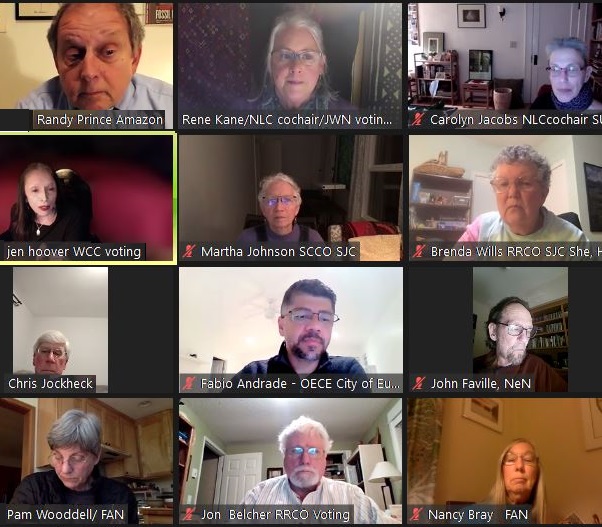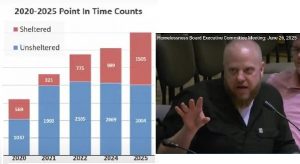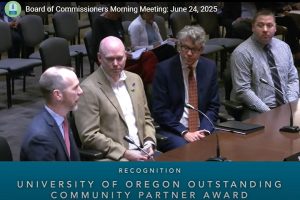Neighborhood leaders discuss ‘most organized hate speech in last 4 years’
7 min read
Neighbors respond to the distribution of antisemitic fliers. At the Neighborhood Leaders Council Feb. 28:
[00:00:07] Rene Kane (NLC co-chair): Carolyn (Jacobs) and I became acting co-chairs of NLC a month ago and, we thought it would be really interesting to get an update from our social justice committees across the city. And, unfortunately, current events made it really timely that we have this meeting today. And as many of you know, several neighborhoods have been impacted with antisemitic fliers at people’s houses.
[00:00:34] Harry Sanger (River Road): I was actually, unfortunately one of the recipients of one of these packets and woke up Sunday morning and wife had just gone with the kids and I saw a little bag that I thought had fallen out from the car and it was just disgusting propaganda.
[00:00:48] Rene Kane: And as one of my neighbors said, you know, on his front sidewalk. So, as that unfolded, we realized that it was more important than ever. So what we’d like to do first is, and this is everybody, if your neighborhood has been impacted by the recent distribution of antisemitic flyers, so raise your hand. Go ahead, Dennis.
[00:01:16] Dennis Hebert (Southeast Neighbors): I heard pretty much a few hours after it happened on Sunday morning about it in our neighborhood, and the only instances I’ve heard have been pretty much between East Amazon and University Street. They seem to have targeted just several streets and that’s all that I’ve been aware of as far as that goes in our neighborhood that’s been reported.
[00:01:40] Rene Kane: Thanks Dennis. Nancy?
[00:01:45] Nancy Bray (Friendly Area Neighbors): On Lawrence Street between 18th and 19th, and this neighbor said he also saw them going, that would be east on 19th towards Willamette Street. We do know that there was one in Jefferson Westside at 14th and Washington, so, yep.
[00:02:03] Rene Kane: Okay. Gary.
[00:02:07] Gary Haliski (Santa Clara): It probably started up here on Willow Springs. Went down Altura, Victoria, Chimney Rock, Lancaster, kept going and hit the street right before Walgreens, then it skipped and it hit Maxwell on the other side of Beltline and pretty much every single house on at least the right hand of the street, tossed out from a pickup that somebody caught on their camera. And it was a long stretch. That’s a two-mile stretch and some zigzagging in there. (My wife and I went out and picked ’em up and tried to get rid of them.)
[00:02:38] Rene Kane: Thanks Gary. Fabio, do you want to give us an update from your work with EPD about what the extent of the distribution was?
[00:02:48] Fabio Andrade (City of Eugene): Hi everyone. Thanks for addressing this subject. It is very important for our community. We do not have detailed information on all the locations where the flyers were distributed. Some of the initial reports were sent to EPD (Eugene Police Department). Some of the reports were just through social media or local news organizations. Now all the intake is being done by the state.
[00:03:11] So this is an evolving situation. It is not an isolated incident. We had that happen last year in a few neighborhoods. Then we had distribution of the similar fliers in the Springfield and now again in Eugene.
[00:03:25] So there is an organization that claims to be behind the fliers. It’s a network that spreads a hate message and mostly anti-Jewish message, antisemitic message. So because it’s initially not a criminal incident, we are limited on how much investigation Eugene Police can do about these flyers. So they monitor the situation.
[00:03:50] More recently there was some information regarding a call to action around the ‘National Day of Hate.’ And EPD had an approach on how to deal with that information. There was no direct threat of physical violence to our community, so the detectives were just monitoring the situation and coordinating with the state and federal partners.
[00:04:13] In the past four years, these fliers have been the most organized expression of hate speech that we have had.
[00:04:20] Rene Kane: Thanks Fabio. We have at least three groups presenting tonight on their social justice committees or equity committees. (There are several names that people use.) And we’re looking forward to hearing what people have to say. Let’s start out with Martha Johnson from Santa Clara Community Organization.
[00:04:43] Martha Johnson (Santa Clara): We formed in spring of 2021 in response to some racist and sexist graffiti that showed up on the wall of a business in our neighborhood. We have a separate bias response team that has no membership requirements and no regular meetings. And its sole purpose is to provide a pool of local volunteers who are willing to step up and help as needed when bias incidents or hate crimes happen in Santa Clara.
[00:05:05] Our bias response team has standing SCCO (Santa Clara Community Organization) board approval to take action in the moment, without going to the board to ask for permission first, in response to neighborhood incidents of hate or bias, with a requirement that we’ll make a report back to them on any actions we take at the next SCCO meeting.
[00:05:23] And our activities include, so, most recently the response to the anti-Jewish fliers, Gary did a fantastic job (Thank you, Gary) in coordinating within a week, a really nice response. He worked with CALC, with SURJ and Brenda (Wills, River Road). And we got 50 volunteers. And we canvased how many houses? (We think we hit about 400.) Yeah. So yeah, that was all done on Sunday afternoon in the rain and the hail and the snow.
[00:05:52] Our main thing that we do on an ongoing basis is we provide a monthly education topic on social justice, and we also have done some ongoing personal work on anti-racism and whiteness and kind of sharing journal entries with prompts from the Me and White Supremacy book. And more recently from the book, Waking Up White.
[00:06:10] Rene Kane: Martha, really appreciate all the work you did, and have done and will do. We’re going to hear from Nancy Bray from Friendly Area Neighbors.
[00:06:19] Nancy Bray (Friendly Area Neighbors): So we formed in the fall of 2017 and that was in response to a concern from a neighbor and also with a goal of being proactive. So a neighbor who was a single parent, a transgender child, had heard that a neo-Nazi family had moved across the street. So she asked how FAN could help. And we got the word out through Friendly Flyer, announced a meeting. We had eight people come to the first meeting. And with that group we decided we wanted to organize a launch event. And about 40 people came to that event, which we thought was great.
[00:06:58] So one of our main activities has been murals. And this started in response to a racist graffiti incident in Westmoreland Park and I can say this project just mushroomed. So we now have three murals on that building. Then last spring we had the opportunity to collaborate with Beyond Toxics to do a fourth mural on the Coleman Center.
[00:07:23] And the mural is The Willamette Wetlands of the Kalapuya. And if you haven’t seen it, please go see it. It’s a beautiful mural with, Susan Applegate was our muralist, Esther Stutzman, Kalapuya – Coos elder, she and Susan worked together to create the design.
[00:07:43] And then I have to say, we had an arson incident on Feb. 4 and our kiosk, with our Kalapuya displays, was destroyed by arson.
[00:07:53] Sgt. Wayne Dorman from the Special Investigations Bias Crime Unit followed up, and it did not meet the criteria of a hate crime. There wasn’t a particular victim, and it wasn’t damage to somebody’s personal property. Certainly, it was somebody with intent to destroy that kiosk. It was not just a bulletin board with random fliers and ‘Dog Lost’ notices on it. It had permanent displays. But you know, it’s not a hate crime. It was moved from criminal mischief to arson, but it’s an open arson case and we are working with Parks and Open Space and Beyond Toxics to hopefully rebuild that kiosk.
[00:08:39] Rene Kane: Next up we have Drae Charles.
[00:08:41] Drae Charles (City of Eugene and Active Bethel Community): We’re actually in an active rebuild. I moved into Bethel middle of last year, and connected with Tai (Pruce-Zimmerman) pretty quickly and he let me know that they had this committee and was looking for support and getting it back off the ground. And so we’ve been actively rebuilding it since middle to end of last year.
[00:09:00] It’s a proactive effort. There was no incident in particular that we were responding to at the time. The goal is to have a nine-member advisory panel with multiple stakeholders from various communities: Local youth, one local educator, we want two at-large members, two from racial or ethnic minority groups, one from a religious minority group, one from our immigrant community, and then one from ABC (Active Bethel Community).
[00:09:25] The focal point right now is really just building out our foundational structures so that no matter who steps into these roles in the future, this committee can be sustained. You never want something this important to fall apart because members leave.
[00:09:43] Rene Kane: I’m curious from the groups that are represented here, I know Santa Clara and River Road have worked together pretty closely. I’m curious how you think, maybe all of the four groups (and I know there’s a dormant group in Southeast Neighbors that might, you know, get some fuel behind it), how you might be able to work together in the future?
[00:10:13] Carolyn Jacobs (South University): What I would love is to hear them interact like they’re doing tonight. It’s really good for neighborhoods to talk to each other, to engage with each other. I mean, we have so much to learn from each other. I just think these meetings are really important. Sort of what NLC is really good for, right?
[00:10:34] John Q: Neighborhoods share information about recent bias incidents. To get involved and help, contact your neighborhood association.





